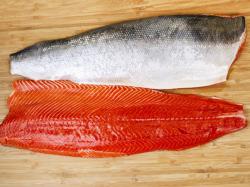Wild Alaska Salmon: A Prized Healthy & High Quality Lean Protein Source
January 16, 2017 | 2 min to read

JUNEAU, Alaska — Known for its wild salmon, crab and whitefish varieties, Alaska is home to dozens of different species of seafood, including more than 90 percent of the wild salmon harvested in the United States. From the rich, robust flavor of sockeye to the firm texture of coho, consumers can rely on the five unique species of wild Alaska salmon as a food choice that is nutritious, low in saturated fat, and high in essential vitamins and heart-healthy omega-3 fatty acids.
Recent news reports have mentioned parasites in Alaska salmon; however, Alaska salmon is among the highest quality seafood and safe for consumer consumption. All commercially harvested Alaska seafood, which accounts for more than 60 percent of all the seafood harvested in the United States, is processed in accordance with strict Food and Drug Administration (FDA) regulations, including parasite controls. These regulations specifically guard against potential harm to ensure that eating both salmon sushi and fully cooked salmon can be safely enjoyed.
According to FDA guidelines, seafood needs to be frozen to -4°F or below for seven days if it is to be consumed raw for food safety reasons. Salmon that has not been properly frozen should be cooked thoroughly to an internal temperature of 140°F before consumption. For any raw or semi-raw preparations, the Alaska Seafood Marketing Institute (ASMI) always recommends using properly frozen seafood.
"The Alaska seafood industry adheres to standards that provide safe seafood products. The Alaska Department of Fish and Game works closely with the Alaska seafood industry to ensure that healthy fish are available for consumers," said Dr. Ted Meyers, Alaska Department of Fish and Game Principal Fish Pathologist.
Only 6 percent of wild Alaska salmon is released fresh from Alaska, the majority is frozen. The catch is chilled and then commercially frozen in accordance with FDA guidelines, ensuring the seafood is kept at the peak of quality, freshness and safe from bacteria and parasites.
"Alaska is proud of its heritage as a supplier of some of the highest quality and most delicious seafood in the world," says Alexa Tonkovich, executive director of ASMI. "We go to great lengths to ensure that all of our seafood, including wild Alaska salmon, meets the highest quality standards for our consumers' safety and enjoyment."
For more information on wild Alaska salmon, visit www.wildalaskaseafood.com, and follow Alaska Seafood on Facebook and Twitter.
About Alaska Seafood:
The Alaska Seafood Marketing Institute (ASMI) is a partnership of the State of Alaska and the Alaska seafood industry. ASMI works to promote the benefits of wild and sustainable Alaska seafood and offer seafood industry education. For more than 50 years, Alaska has been dedicated to sustainable seafood. It's so essential to our way of life that our constitution mandates that fish are "utilized, developed and maintained on the sustained yield principle." The seafood industry is Alaska's largest private sector employer, and as a result, Alaskans understand the need to protect the fisheries and surrounding habitats for future generations. We're proud of our leadership in sustainable management, which has led to an ever-replenishing supply of wild seafood for markets around the world.
Source: The Alaska Seafood Marketing Institute (ASMI)
